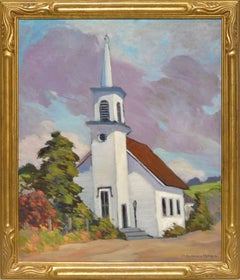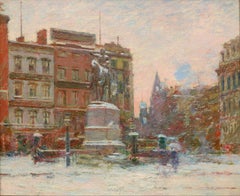Mary DeNeale Morgan Art
Mary DeNeale Morgan was born in San Francisco, 1868. She was taken to Oakland in 1872, where the painter William Keith was her first teacher. She was precocious. In 1886, she enrolled in the California School of Design in San Francisco and studied with Emil Carlsen and Amédée Joullin until 1890. Morgan paid her first visit to Carmel in 1903. In 1910, she returned to buy the studio and home of the late Sydney Yard, located next to what is now the Cypress Inn on Lincoln. From then on through the 1940s, her studio was filled with tourists, buyers, other artists and friends. The building — ever-expanding with new rooms and more paintings — became a meeting place for civic activists. Morgan’s style was her own, containing elements of the Barbizon School, sometimes tonalist or California Impressionist, but always distinctly her own, usually in vivid color with broad, bold strokes, sometimes laid on with a palette knife.
When pressed to say what school of painting she belonged to, she replied that she was a "horse and buggy artist." She refused to be typed. Morgan’s favorite subject was the Monterey cypresses. When asked if she didn't tire of that subject, she replied that she "would stick by her cypress trees till they sink into the sea, or — what is just as tragic and final — be hopelessly built-around." In 1915, she won a Silver Medal at the Panama-Pacific International Exposition in San Francisco. In 1928, she was selected by Scribner's Magazine as one of the nation's foremost women artists. Morgan rarely traveled outside Carmel, never outside the U.S., but had one-woman shows in San Francisco; New York; Washington, D.C.; and Chicago.
(Biography provided by Robert Azensky Fine Art)
1920s American Impressionist Mary DeNeale Morgan Art
Masonite, Oil
19th Century American Impressionist Mary DeNeale Morgan Art
Oil
Mid-20th Century American Impressionist Mary DeNeale Morgan Art
Oil, Board
Early 1900s American Impressionist Mary DeNeale Morgan Art
Canvas, Oil
1920s American Impressionist Mary DeNeale Morgan Art
Masonite, Oil
20th Century American Impressionist Mary DeNeale Morgan Art
Canvas, Oil
2010s American Impressionist Mary DeNeale Morgan Art
Oil, Wood
1910s American Impressionist Mary DeNeale Morgan Art
Canvas, Oil
Mid-20th Century American Impressionist Mary DeNeale Morgan Art
Masonite, Oil
Early 1900s American Impressionist Mary DeNeale Morgan Art
Canvas, Oil
Early 1900s American Impressionist Mary DeNeale Morgan Art
Oil, Board
Late 20th Century American Impressionist Mary DeNeale Morgan Art
Oil, Masonite
2010s American Impressionist Mary DeNeale Morgan Art
Oil, Wood


